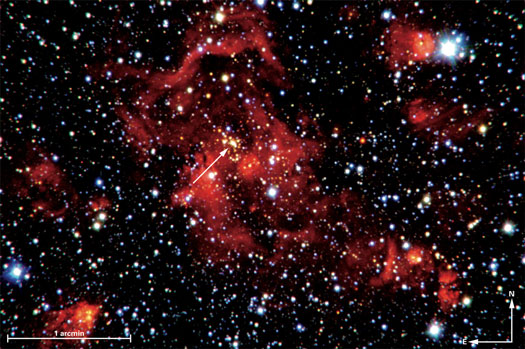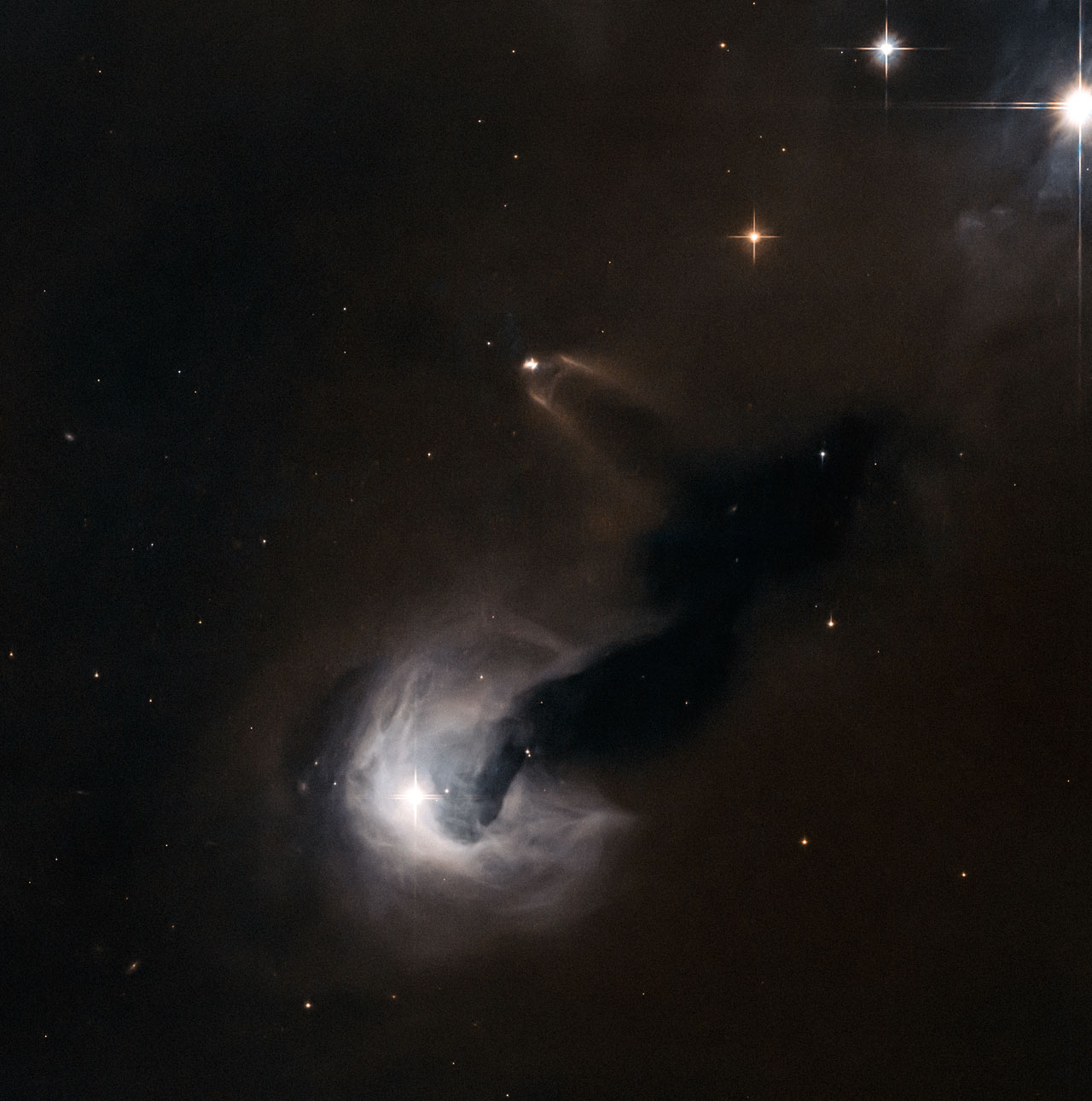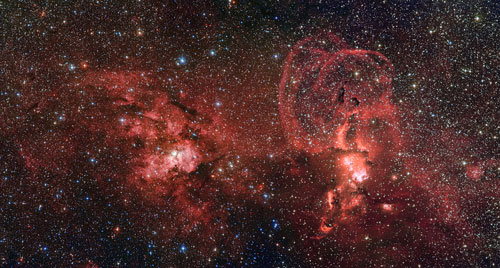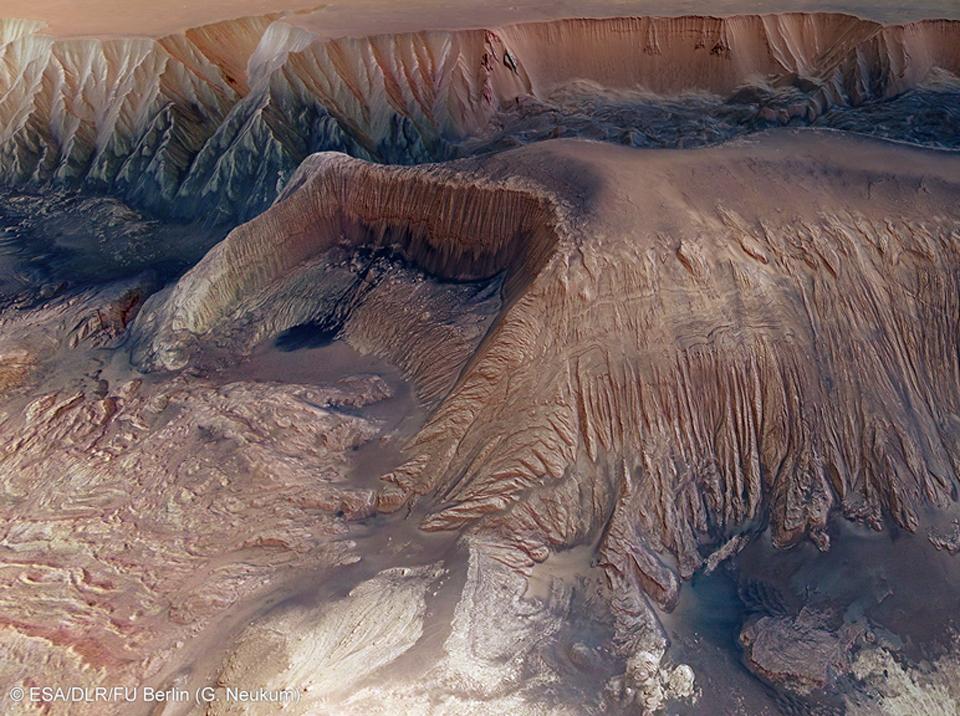
Thursday, August 28, 2014
astro picture for the day
Image credit, ESO's New Technology Telescope and the Large Binocular Telescope
The arrow is pointing to the most massive star ever found(so far!). Not much of a picture but why not?
- Science/Tech news,
Nanoshuttles propelled by motor proteins sequentially assemble molecular cargo in a microfluidic device
“We need to continue to optimise the system and learn more about how we can design the individual components of this nanoshuttle system to make these applications possible in the future,”
This further link shows some more schematic pictures of interest and movies of it working! This is small time compared to where all this will lead, but the pictures are exciting anyways! Nanoshuttles: Harnessing Biological Motor Proteins to Build Nanoscale Transport Systems
Monday, August 25, 2014
astro picture for the day / John Stillwell "What does depth mean in mathematics?
ESA/NASA Hubble Space Telescope image
John Stillwell - "What Does 'Depth' Mean in Mathematics?"
For some strange reason, the video linked above about John Stillwell's latest public lecture doesn't show up amongst the youtube selections; but, about the lecture . . .
He tries to show the big ideas throughout mathematics history. He strangely goes from modern times back in time. He of course doesn't cover everything. In fact, I find his viewpoint of "what steps came before", and "how many great mathematicians before the final logical proof" viewpoint a bit limiting. As usual, mathematics is deeper and more of a complex whole than any simple description. A "implications and developments after the great theorem is made' viewpoint makes certain theorems even more important.
The fundamental theorem of algebra implications, mentioned by him for sure gets a different perspective from its later implications instead of what led up to it. The fundamental theorem of algebra led to 'varieties' by David Hilbert(just one thing he did). The fundamental theorem of algebra proves the number of solutions of any polynomial is equal to the degree of the equation. And it does so topologicaly(this was proven by Frederick Gauss, hence Gauss was aware of something 'topological'; he knew of topological properties from 'genus' properties of number theory as well). The number of solutions is pictured as intersections of a curver around a Cartesian plane. One could generalize to different geometric shapes and this is what David Hilbert does. Varieties were used by Manjul Bhargava farelly recently to solve number theory problems. I actually link to a lecture of his way back in this blog. Manjul was one of the Fields medal winners a week or two ago. His work has opened up non-commutative algebras and made sense of octonians for the first time. Back in the early 1800s, Galois came up with abstract algebras of groups and fields to prove that there is no general closed form solution to the fifth degree equation(like the quadratic formula for the second degree equation; something that goes back to the Babylonians a thousand years before the Greeks did their best stuff). This opened up algebra like never before. Before, algebra was just quadratic equations and then solutions to higher degree equations that they could solve. Another side of algebra was opened up in invariant theory. Invariant theory kind of comes out of matrices and systems of equations type of stuff. Really, its substitutions of equations in each other that leaves invariants. The b^2-4ac in the square root radical of the quadratic formula is an invariant. Mathematicians from Boole to Cayley found lots of invariants and started solving algebra and geometric problems from invariants in the early to mid and then late 1800s. Emmy Noether in the early 1900s came up with commutative and non-commutative algebras. The non-commutative algebras unified the invariants side of algebra and the abstract algebra. But, her work remarkably became eclipsed a little bit by the lie algebraic work for much of the rest of the 20th century. Manjul Bhargava's work is one generalization that has opened up the field again. Octonians are further generalisations beyond quaternions which are themselves generalisations past complex numbers. All this 'fundamental theorem of algebra' is just one example.
The fundamental theorem of the calculus is another. While its a proof, there is room in the interaction between the differential and integral calculus unified by the fundamental theorem of the calculus for more. This led to lots of real analyses.
Going back further into time, the Pythagorean theorem led to Diophantine analyses in 'Pythagorean triples', irrational numbers in the square root of two, and the number theory of the pellian equations. Other Greek findings had implications as well.
The five platonic solids led to topology. The squaring of the circle led to transfinite numbers. The other delian problems of trisection of an angle and duplication of a cube led to abstract algebra(or could only really be solved by abstract algebras).
Wednesday, August 20, 2014
astro picture for the day
Image credit, Michael Jaeger. (Comet Jacques)
Science news extra,
Dust reveals ancient origin for Saturn's rings
Such a delecate structure in existence for so long!(Saturn's rings). Now, if we can just determine how long Jupiter's red spot has been raging!
A bit of a mysterious northern Greece(ancient Mycenae) tomb has been discovered. It dates to 4th century B.C. We should know who's tomb it is. Knowing who's tomb this is could prove a little bit interesting; and who knows what else they find!
Massive Hellenistic Tomb Discovered in Northern Greece
astro picture for the day / quote for the day
Image credit: ESA/NASA Hubble Space Telescope
"The ancients who wished to illustrate illustrious virtue throughout the Kingdom first ordered well their own states. Wishing to order well their states, they first regulated their families. Wishing to regulate their families, they first cultivated their persons. Wishing to cultivate their persons, they first rectified their hearts. Wishing to rectify their hearts, they first sought to be sincere in their thoughts. Wishing to be sincere in their thoughts, they first extended to the utmost their knowledge. Such extension of knowledge lay in the investigation of things." - Confusious
astro picture for the day / quote for the day
Image credit: ESO
"Philosophy(nature) is written in that great book which ever lies before our eyes - I mean the universe - but we cannot understand it if we do not first learn the language and grasp the symbols in which it is written. The book is written in the mathematical language, and the symbols are triangles, circles, and other geometric figures, without whose help it is impossible to comprehend a single word of it; without which one wanders in vain through a dark labyrinth." - Galileo
Tuesday, August 19, 2014
astro picture for the day
Contrasting Terrains on Comet Churyumov-Gerasimenko
Image Credit: ESA / Rosetta / MPS for OSIRIS Team; MPS/UPD/LAM/IAA/SSO/INTA/UPM/DASP/IDA
Pretty good history of the Poincare conjecture. How the conjecture led to all kinds of other problems and concepts. As Josh Morgan and mathematicians well known, Henri Poincare is considered the first to make topology a field of mathematics like algebra, geometry, and analyses(calculus). The history of topology goes back to Leondard Euler and the famous Konigsberg bridge problem. Frederick Gauss had some vague notions about it - specifically about genus of a curve. His student Bernard Riemann derived much topology from complex analyses. He mapped a sphere onto a plane and showed that the two valued complex numbers leads to a two sheeted surface. Or, a sphere is topologically a two sheeted surface. Riemann surfaces classify complex analyses functions. The Mobius strip was also invented back in the 1800s before Henri Poincare's work.
Thursday, August 14, 2014
astro picture for the day
Image credit: Hubble Space Telescope
Science/Technology news extra,
Scientists fold RNA origami from a single strand
Paul Rothemund innovated dna-origami, and it's been exciting; now, he's back with Rna-origami.
Synthetic biology could solve medical and energy problems that nanotechnologists hoped/thought nano-manufacturing would solve. But, nanomanufacturing is still desired for manufacturing of materials on both a nanoscale and macroscale. Synthetic biology cannot do this; the question in my mind was always, how can we combine synthetic biology with dna-nanotechnology?
Well, maybe dna-nanotechnology still isn't quite combined with synthetic biologoy; but, here, we have rna-nanotechnology combined with synthetic biology!
and from the article,
"The primary application for these molecular shapes is to build scaffolds for arranging other microscopic components, such as proteins, into groups that allow them to work together. For example, using the scaffolds as a foundation to build a microscopic chemical factory in which products are passed from one protein enzyme to the next." Andersen explains.
Wednesday, August 13, 2014
astro picture for the day
Image Credit & Copyright: ESA/DLR/FU Berlin (G. Neukum)
some thought for the day extras. these are notes from conversations elsewhere,
"
Without the feedback loop to the real world that comes from being embodied there will be no AI. Ungrounded symbol-shuffling attempts at AI such as Cyc have always failed. Simulations are and will always be crude due to scaling laws. Only the real world has the complexity, coherence and detail needed. Certainly a lot of overhead can be eliminated in the autonomic nervous system, but there is a good deal needed to operate a body in the real world.
These researchers are operating with an oversimplified and wrong idea of how neurons operate, which is even further simplified in the hardware design to the point of being a useless caricature of real brains. They haven't even begun to model the sonic and mechanical-resonance aspects of neural transmission and plasticity. They still use the disproven Hodgkin-Huxley model (rather than Heimburg's soliton model) as their base, and virtually ignore the necessity of low-speed impulses to neural function, substituting high-speed communications that do not fulfill timing and phase coordination functions. Cytoskeletal dynamics and their effects on morphology and connectivity are entirely ignored, the synapse connections being put in by hand and with crude rules-of-thumb.
Maybe some way can be found to make it work to some extent, but they don't even seem to know what they're sweeping under the rug. They have an infinitesimal chance of success at producing a real AI no matter how many billions of these poor approximations to neurons they manage to pile up." - MUltan( that's what he calls himself)
for which I replied,
"I've always agreed that life is a stable non-equilibrium structure as Ilya Prigogine argues.
I'm surprised the A.I. guys don't get into Ilya Prigogine's stable structures ideas; seems to me the idea that life is connected to the environment through numerous feedback loops fits in with Marvin Minsky's 'Society of Mind' idea. The society of mind . . . ideas mixing and matching(some would say competing) would come from these numerous feedback loops;" - Flashgordon!
Tuesday, August 12, 2014
astro picture for the day / quote for the day
Credit: NASA / JPL-Caltech
"This, therefore, is mathematics: she reminds you of the invisible form of the soul; she gives life to her own discoveries; she awakens the mind and purifies the intellect; she brings light to our intrinsic ideas; she obolishes oblivion and ignorance which are ours by birth." Proclus
Monday, August 11, 2014
astro picture for the day / quote for the day
ESA/NASA Hubble Space Telescope image
"- . . . someone who had begun to learn geometry from Euclid, when he had learned the first theorem, asked Euclid "What shall I get out of what he learns?" Euclid called his slave and said "Give him threepence since he must make gain out of what he learns." Strabasus, about Euclid
Saturday, August 9, 2014
astro picture for the day / quote for the day
Image Credit: Cassini Imaging Team, SSI, JPL, ESA, NASA
Quote for the day,
"Usually called unnecessary things is not understood. It is a case of revenge, and as usually mathematics and physics are not included, they are declared unnecessary." Fontenelle (1699)
Here's the latest enticing video of Pluto with Charon orbiting Pluto. Charon was discovered in 1978. Astronomers have discovered four more moons around Pluto(not as big as Charon).
Wednesday, August 6, 2014
astro picture for the day / quote for the day
image credit: ESA/NASA Rosetta spacecraft
Well, this is a comet. If I recall correctly, the Japanese flew a spacecraft by a comet recently as well; that comet wasn't much more picturesque. Maybe, as we get close up of its features, we'll see interesting things.
Quote for the day,
"Where there is a will there is a way." - Shona Proverb
Science/Technology extra,
Tiny chip mimics brain, delivers supercomputer speed
Friday, August 1, 2014
astro picture for the day / quote for the day
Image Credit & Copyright: Jimmy Walker
Quote for the day,
"Mother is God number two." ~Chewa Proverb
Justin Martyr study reveals late date to Gospels
Subscribe to:
Posts (Atom)













